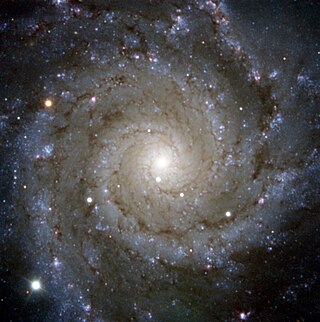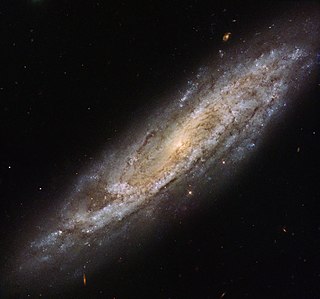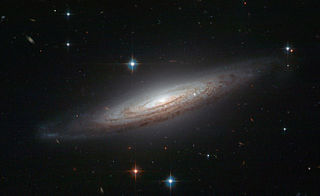
Messier 61 is an intermediate barred spiral galaxy in the Virgo Cluster of galaxies. It was first discovered by Barnaba Oriani on May 5, 1779, six days before Charles Messier discovered the same galaxy. Messier had observed it on the same night as Oriani but had mistaken it for a comet. Its distance has been estimated to be 45.61 million light years from the Milky Way Galaxy. It is a member of the M61 Group of galaxies, which is a member of the Virgo II Groups, a series of galaxies and galaxy clusters strung out from the southern edge of the Virgo Supercluster.

The Whirlpool Galaxy, also known as Messier 51a (M51a) or NGC 5194, is an interacting grand-design spiral galaxy with a Seyfert 2 active galactic nucleus. It lies in the constellation Canes Venatici, and was the first galaxy to be classified as a spiral galaxy. It is 7.22 megaparsecs away and 23.58 kiloparsecs (76,900 ly) in diameter.

Messier 81 (also known as NGC 3031 or Bode's Galaxy) is a grand design spiral galaxy about 12 million light-years away in the constellation Ursa Major. It has a D25 isophotal diameter of 29.44 kiloparsecs (96,000 light-years). Because of its relative proximity to the Milky Way galaxy, large size, and active galactic nucleus (which harbors a 70 million M☉ supermassive black hole), Messier 81 has been studied extensively by professional astronomers. The galaxy's large size and relatively high brightness also makes it a popular target for amateur astronomers. In late February 2022, astronomers reported that M81 may be the source of FRB 20200120E, a repeating fast radio burst.

Messier 74 is a large spiral galaxy in the equatorial constellation Pisces. It is about 32 million light-years away from Earth. The galaxy contains two clearly defined spiral arms and is therefore used as an archetypal example of a grand design spiral galaxy. The galaxy's low surface brightness makes it the most difficult Messier object for amateur astronomers to observe. Its relatively large angular size and the galaxy's face-on orientation make it an ideal object for professional astronomers who want to study spiral arm structure and spiral density waves. It is estimated that M74 hosts about 100 billion stars.

NGC 6946, sometimes referred to as the Fireworks Galaxy, is a face-on intermediate spiral galaxy with a small bright nucleus, whose location in the sky straddles the boundary between the northern constellations of Cepheus and Cygnus. Its distance from Earth is about 25.2 million light-years or 7.72 megaparsecs, similar to the distance of M101 in the constellation Ursa Major. Both were once considered to be part of the Local Group, but are now known to be among the dozen bright spiral galaxies near the Milky Way but beyond the confines of the Local Group. NGC 6946 lies within the Virgo Supercluster.

NGC 891 is an edge-on unbarred spiral galaxy about 30 million light-years away in the constellation Andromeda. It was discovered by William Herschel on October 6, 1784. The galaxy is a member of the NGC 1023 group of galaxies in the Local Supercluster. It has an H II nucleus.

NGC 7331, also known as Caldwell 30, is an unbarred spiral galaxy about 40 million light-years (12 Mpc) away in the constellation Pegasus. It was discovered by William Herschel in 1784. NGC 7331 is the brightest galaxy in the field of a visual grouping known as the NGC 7331 Group of galaxies. In fact, the other members of the group, NGC 7335, 7336, 7337 and 7340, lie far in the background at distances of approximately 300–350 million light years.

NGC 4725 is an intermediate barred spiral galaxy with a prominent ring structure, located in the northern constellation of Coma Berenices near the north galactic pole. It was discovered by German-born British astronomer William Herschel on April 6, 1785. The galaxy lies at a distance of approximately 40 megalight-years from the Milky Way. NGC 4725 is the brightest member of the Coma I Group of the Coma-Sculptor Cloud, although it is relatively isolated from the other members of this group. This galaxy is strongly disturbed and is interacting with neighboring spiral galaxy NGC 4747, with its spiral arms showing indications of warping. The pair have an angular separation of 24′, which corresponds to a projected linear separation of 370 kly. A tidal plume extends from NGC 4747 toward NGC 4725.

The Katzman Automatic Imaging Telescope (KAIT) is an automated telescope used in the search for supernovae.

NGC 2207 and IC 2163 are a pair of colliding spiral galaxies about 80 million light-years away in the constellation Canis Major. Both galaxies were discovered by John Herschel in 1835.

NGC 1309 is a spiral galaxy located approximately 120 million light-years away, appearing in the constellation Eridanus. It is about 75,000 light-years across, and is about 3/4s the width of the Milky Way. Its shape is classified as SA(s)bc, meaning that it has moderately wound spiral arms and no ring. Bright blue areas of star formation can be seen in the spiral arms, while the yellowish central nucleus contains older-population stars. NGC 1309 is one of over 200 members of the Eridanus Group of galaxies.

The known history of supernova observation goes back to 1006 AD. All earlier proposals for supernova observations are speculations with many alternatives.

NGC 4639 is a barred spiral galaxy located in the equatorial constellation of Virgo. It was discovered by German-born astronomer William Herschel on April 12, 1784. John L. E. Dreyer described it as "pretty bright, small, extended, mottled but not resolved, 12th magnitude star 1 arcmin to southeast". This is a relatively nearby galaxy, lying approximately 72 million light-years away from the Milky Way. It is a companion to NGC 4654, and the two appear to have interacted roughly 500 million years ago. NGC 4639 is a member of the Virgo Cluster.

NGC 2608 is a barred spiral galaxy located 93 million light-years away in the constellation Cancer. It is 62,000 light-years across, and about 60% of the width of the Milky Way. It is considered a grand design spiral galaxy and is classified as SB(s)b, meaning that the galaxy's arms wind moderately around the prominent central bar.

NGC 2770 is a spiral galaxy in the northern constellation of Lynx, near the northern constellation border with Cancer. It was discovered by German-born astronomer William Herschel on December 7, 1785. J. L. E. Dreyer described it as, "faint, large, much extended 150°, mottled but not resolved, 2 stars to north". NGC 2770 was the target for the first binocular image produced by the Large Binocular Telescope.

NGC 7424 is a barred spiral galaxy located 37.5 million light-years away in the southern constellation Grus. Its size makes it similar to our own galaxy, the Milky Way. It is called a "grand design" galaxy because of its well defined spiral arms. Two supernovae and two ultraluminous X-ray sources have been discovered in NGC 7424.
SN 2005gl was a supernova in the barred-spiral galaxy NGC 266. It was discovered using CCD frames taken October 5, 2005, from the 60 cm automated telescope at the Puckett Observatory in Georgia, US, and reported by Tim Puckett in collaboration with Peter Ceravolo. It was independently identified by Yasuo Sano in Japan. The supernova was located 29.8″ east and 16.7″ north of the galactic core. Based upon its spectrum, this was classified as a Type IIn core-collapse supernova. It has a redshift of z = 0.016, which is the same as the host galaxy.

NGC 634 is a spiral galaxy, lying at a distance of 217.1 megalight-years away from the Milky Way in the northern constellation of Triangulum. This object was discovered on 26 October 1876 by French astronomer Édouard Stephan. It is inclined by an angle of 82.4° to the line of sight from the Earth, and thus is being viewed nearly edge on.

A type Iax supernova is a rare subtype of type Ia supernova, which leaves behind a remnant star, known as zombie star, rather than completely dispersing the white dwarf. Type Iax supernovae are similar to type Ia, but have a lower ejection velocity and lower luminosity. Type Iax supernovae may occur at a rate between 5 and 30 percent of the Ia supernova rate. Thirty supernovae have been identified in this category.

NGC 6753 is a massive unbarred spiral galaxy, seen almost exactly face-on, in the southern constellation of Pavo. It was discovered by the English astronomer John Herschel on July 5, 1836. The galaxy is located at a distance of 142 million light years from the Milky Way, and is receding with a heliocentric radial velocity of 3,140 km/s. It does not display any indications of a recent interaction with another galaxy or cluster.



















